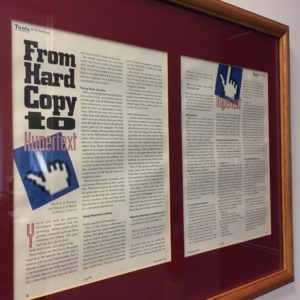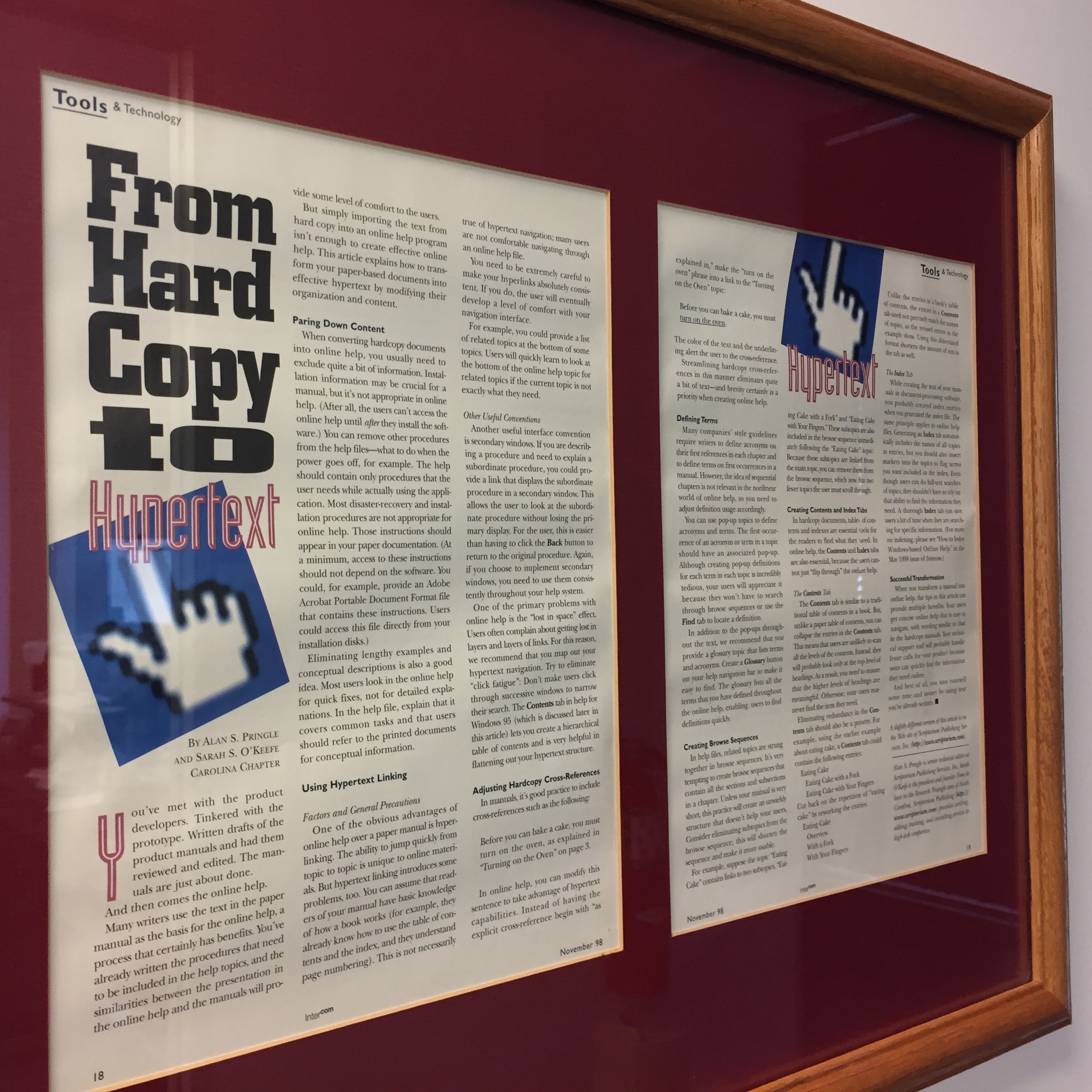Scriptorium 20th anniversary
This post is part of Scriptorium’s 20th anniversary celebration.
I’m finding it surprisingly difficult to write a recap of Scriptorium from 1997 to today. It feels as though the company has been around forever, but also as though 20 years went by in a flash.
The startup phase
Scriptorium happened because of:
- My unusual combination of knowledge of German and PageMaker (in 1994 or so)
- An unsuccessful merger followed by massive layoffs
Let’s review.
Around 1994, I was working for Seer Technologies as a production editor. At Seer, I was knee-deep in FrameMaker templates, bluelines, and early Acrobat PDF work. I took on a freelance side gig working for Interactive Magic, a computer game company. The project come to me because my Seer manager, Brad Hessel, had connections in the industry and heard that Interactive Magic needed someone who could clean up a not-so-great translation from German to English and who also had expert knowledge of PageMaker. In addition to referring me to his contacts, Brad also approved the arrangement as my manager. Employees were allowed to do side freelance work provided that the work was not directly competitive and that managers signed off.
In early 1995, I went to work for Imonics Corporation (along with several other Seer people) and continued freelancing for Interactive Magic. Imonics grew rapidly from 80 people (when I started) to 500 people in mid-1996. The company was acquired, along with a few similar companies, by a parent company. While at Imonics as Manager of Editing and Standards, I hired one Alan Pringle as a technical editor.
In mid-1996, layoffs began and by the end of 1997, Imonics was basically gone. I was let go in the first round of layoffs.
I spent some time curled up in a fetal position, and then turned my attention to deciding what was next. Again, there were specific circumstances that helped me with the decision:
- Interactive Magic was willing to send me more freelance work.
- Imonics had an information development organization of about 50 people. After the company imploded, my former coworkers ended up at all of the major Triangle high-tech employers. Many of them arrived to discover no tool or editorial support, which gave me a great list of prospective customers.
- On a personal level, I had relatively few expenses and a spouse with a secure job that provided health insurance for both of us.
It was never going to be easier.
I launched into full-time self-employment in late 1996, and officially incorporated Scriptorium in January 1997. Alan Pringle and I were the first two employees. (Alan worked part-time for about six months and then joined full-time.)
Getting established

Intercom article, November 1998, discusses how to transfer paper documentation into online help!
In the first few years, Scriptorium did a lot of production editing–providing the final formatting for documents that were going to be printed. We also did some technical editing and technical writing.
From the beginning, though, our focus was on applying technology efficiently. Some early areas of emphasis include:
- Software training for publishing tools
- Building templates
- Single-sourcing workflows
Evolving with the industry
As technical communication began to shift toward structured content and eventually content strategy, our services grew to include consulting. Instead of focusing only on technical implementation, we also provided input to the design phase–what would the technology decisions be and why?
Today, we break down our services into these areas:
I started my career in technical communication as a production editor. That job is much less common than it used to be–it’s been supplanted by automated formatting (especially in XML workflows) and by the near-extinction of printed, bound technical documentation.
Lessons learned
After 20 years, we have a pretty good idea of how to make sure a project is successful:
- We look for clients who have interesting and challenging content problems.
- We combine our experience from lots of projects with our client’s expert knowledge of their company and their industry.
- We manage both the business relationship and the project relationship carefully.
It’s important to identify the business’s core strengths. In our case, it is combining content development and content technologies effectively. Today, we call that content strategy, but in 10 years, there will likely be another buzzword.
I’ve also learned two other difficult lessons:
- Making accurate predictions is impossible, but you have to do it anyway.
- It’s important to recognize important trends, but you must not chase fads.
Looking ahead
When Scriptorium got started, single sourcing was controversial. Many people argued that it was impossible to write content for use in both print and online contexts. There has been similar pushback against each innovation.
“It’s impossible to use a template without overrides.”
“It’s impossible to produce decent PDF from DITA.”
“It’s impossible to produce decent content from machine translation.”
Our job is to understand the technology without being swayed by vendor hype or user fears. What benefits does a new technology offer? Do those benefits outweigh the pain (there’s always pain)? At what point does the benefit of the new technology override inertia?
In early marketing documents, we described our goal as “streamlining publishing workflows.” Today, we speak broadly about customer-facing content instead of just technical content, and we focus on business goals before looking at technology, but the core business is still the same.
My thanks to all the people who have made these 20 years possible: clients, employees, colleagues, family, friends, and chocolate vendors.
Watch this space for more anniversary posts through the year. You can also catch some delightful artifacts on Twitter via the #scriptorium20 hashtag.
Our first business card and logo, circa 1997. #tbt #scriptorium20 #ChunkyGoldS pic.twitter.com/h9MX4xxUbn
— Scriptorium (@scriptorium) January 12, 2017



Connie Giordano
Congratulations on 20 years! Al and I have known each other almost that long, but we’re only coming up on year 6 of the business thing. Anyway it’s been an awesome experience getting to know and work with you all. Looking forward to the next 20!
Melanie S. Seibert
Congratulations Sarah! What an amazing journey you’ve had so far. I so appreciate your sharing your expertise over the years. Here’s to the next 20!
John Dumbrille
As always – inspiring to read. Sarah I met you briefly at a DITA conference several years back. Real substance. Since then we’ve developed a single DITA source for in app help , role based guides and scorm courses. People like you make real progress possible. Congratulations.
Sarah O'Keefe
Thank you, John!